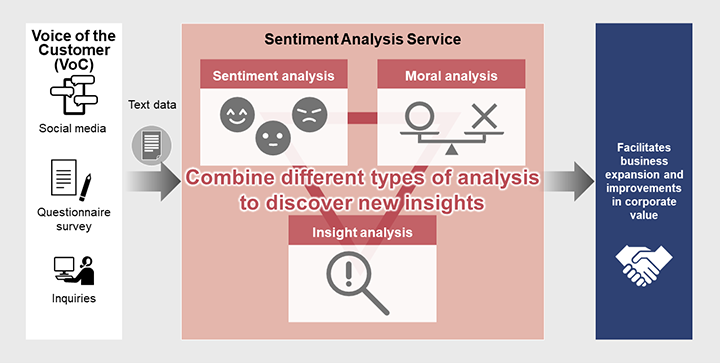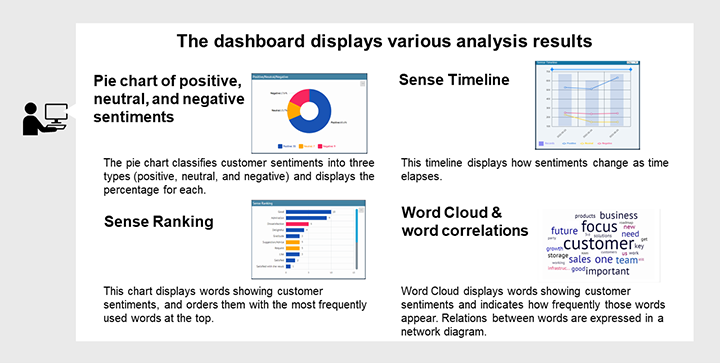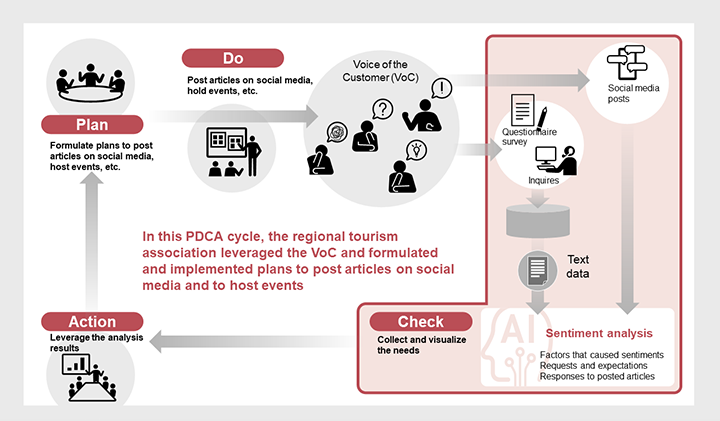Featured customer case
Lumada customer case code: UC-01173S
Sentiment Analysis Service: Predicting the Future Based on the VoC
2022-06-27

Social media posts and questionnaire survey responses provide a lot of information that can serve as valuable input for your business activities.
This article shows a customer case in which the Voice of the Customer (VoC) is collected from such information sources, classified by topic, sentiment, or intention, and then used to take various actions.
Collecting and analyzing information, such as the VoC and product information, enables you to leverage the information in many different marketing activities. For example, you can use the information to understand customer needs and formulate product plans and sales strategies. You can also identify negative customer sentiment and implement measures to mitigate risks.
Hitachi’s Sentiment Analysis Service helps you accelerate the creation of business value. For example, by conducting questionnaire surveys in their organization, HR can pinpoint items requiring improvements in the company and can explore ways to improve the work styles of employees. As another example, a regional tourism association can contribute to regional revitalization by conducting research on tourism.
Co-creating solutions with Lumada, and using AI technologies to classify and visualize the VoC
The Voice of the Customer (VoC) regarding products and services provides information essential to your branding strategy, sales strategy, and service quality improvements. Both positive and negative opinions are valuable when you formulate plans and make improvements to address customer needs.
After an activity such as delivering product information or holding an event such as a product announcement or showcase, public relations teams in business organizations should prepare a report on the impact of the activity. Ideally, such a report should include information such as social media posts, questionnaire survey responses, and inquiries submitted to the contact center. Such information makes it easier for your organization to incorporate the VoC promptly into your business strategy. However, problems such as the following can impact this overall process:
To utilize massive amounts of collected and accumulated data, users must be able to perform quick searches and data visualization must present the search results in an easy-to-understand format.
To ensure that a public relations team can prepare reports faster and provide feedback promptly to business activities, business organizations need to adopt an IT platform that enables users to quickly search massive amounts of accumulated data and provide data visualization of the results.
Hitachi’s Sentiment Analysis Service collects text data, including VoC data, and enables it to be used for analysis. This service employs an AI engine to classify natural-language VoC data into three major categories: positive, neutral, and negative. This service also performs an in-depth classification of the VoC by sentiment. In this way, the service provides a highly accurate analysis of how customers feel about companies or products.
The Sentiment Analysis Service also enables users to quickly search massive amounts of accumulated data to find the information that they want. Linking with various business systems, this service combines business information (for example, information about products, public relations activities, and sales performance) and analysis results and displays the information on a customizable dashboard in an easy-to-understand format. The Sentiment Analysis Service can help ensure that the VoC is reflected in various corporate activities such as branding strategy development, sales and production planning, product development, and risk mitigation.

In addition to analyzing collected data from the perspective of sentiment, the Sentiment Analysis Service can also analyze it from the perspectives of identifying moral values and gaining insights. Such analysis results can be leveraged for various purposes, such as marketing, product planning, sales strategy development, and risk mitigation.
Based on Moral Foundations Dictionaries, which are supported by academic research, the Moral Analysis function provides quantitative visual representations of the moral values hidden behind sentiments, enabling business organizations to objectively identify the moral values in the background. As such, business organizations can carry out their business activities in accordance with moral standards and demonstrate their high ethical standards.
With the Insight Analysis function, Hitachi’s unique algorithm is used to capture unexpected information that might be overlooked. For example, this enables companies to capture minor changes in customer responses buried in a massive amount of data, as well as the opinions of minority groups.
Providing highly accurate data visualization of the voices and feelings of customers about companies or products
The Sentiment Analysis Service analyzes social media posts, questionnaire survey responses, and inquiries to call centers with the focus on sentiment, moral values, and insights. This process identifies customer opinions about companies and products, and provides feedback to business activities.
The Sentiment Analysis Service analyzes text data from social media posts, questionnaire survey responses, and inquires to call centers and identifies and visualizes the Voice of the Customer (VoC) regarding companies and products with high accuracy. The service analyzes the collected text data and business information in terms of sentiment, moral values, and insights to capture unexpected product needs and detect potential causes of internet flaming. Based on the results, business organizations can implement preventive measures against flaming. The service facilitates business expansion and improvements in corporate value.

The Sentiment Analysis Service provides interactive operations, and the GUI (graphical user interface) enables users to easily access insights.
The GUI employs data visualization features such as the following:
A dashboard displays the results of various analyses, enabling active discussions among users and facilitating incubation of new ideas.

This section provides a case example of a regional tourism association, which faced a set of problems encountered by many companies: they found it difficult to assess whether their campaigns would be successful, and they faced difficulties in capturing and properly responding to market needs.
In response to these challenges and in an effort to expand business, this regional tourism association ran a PDCA cycle in which they planned and launched appealing campaigns, events, and information-delivery activities for target customers. The association collected customer feedback on the campaigns as well as responses to articles posted on their official social media accounts. They used the Sentiment Analysis Service to conduct effective analysis and implement the results of the analysis, and obtained clear answers to questions like the following:

By leveraging the results of the analysis, the tourism association successfully conducted campaigns and events that helped revitalize their tourism business. They established a PDCA cycle in which they analyze customer responses in order to improve their campaigns and events. As a result, their social media posts attracted many viewers, resulting in a dramatic six-fold increase in the followers of their official account.
The Sentiment Analysis Service analyzes text data to identify and visualize customer sentiment. Hitachi will expand customer cases to include not only business strategies but also HR activities such as personnel changes, recruitment, and training. With this service, Hitachi will provide extensive support for creating value through corporate activities.
Hitachi will combine this service with other services to provide support for various business activities. For example, Hitachi services can be used to conduct real-time analysis of conversations at a call center to find ways to improve the quality of the service provided by the call center. The services can also be used to visualize employee sentiment and buy-in to the corporate philosophy, and to take action to bring a sense of unity to the entire organization.
For details of our solution, see the information below.
For details about the related solution “Empathy Monitoring Service”, see the following information.
For details about the related solution “Next-Generation Contact Center”, see the information below.
Collecting and analyzing information, such as the VoC and product information, enables you to leverage the information in many different marketing activities. For example, you can use the information to understand customer needs and formulate product plans and sales strategies. You can also identify negative customer sentiment and implement measures to mitigate risks.
Hitachi’s Sentiment Analysis Service helps you accelerate the creation of business value. For example, by conducting questionnaire surveys in their organization, HR can pinpoint items requiring improvements in the company and can explore ways to improve the work styles of employees. As another example, a regional tourism association can contribute to regional revitalization by conducting research on tourism.